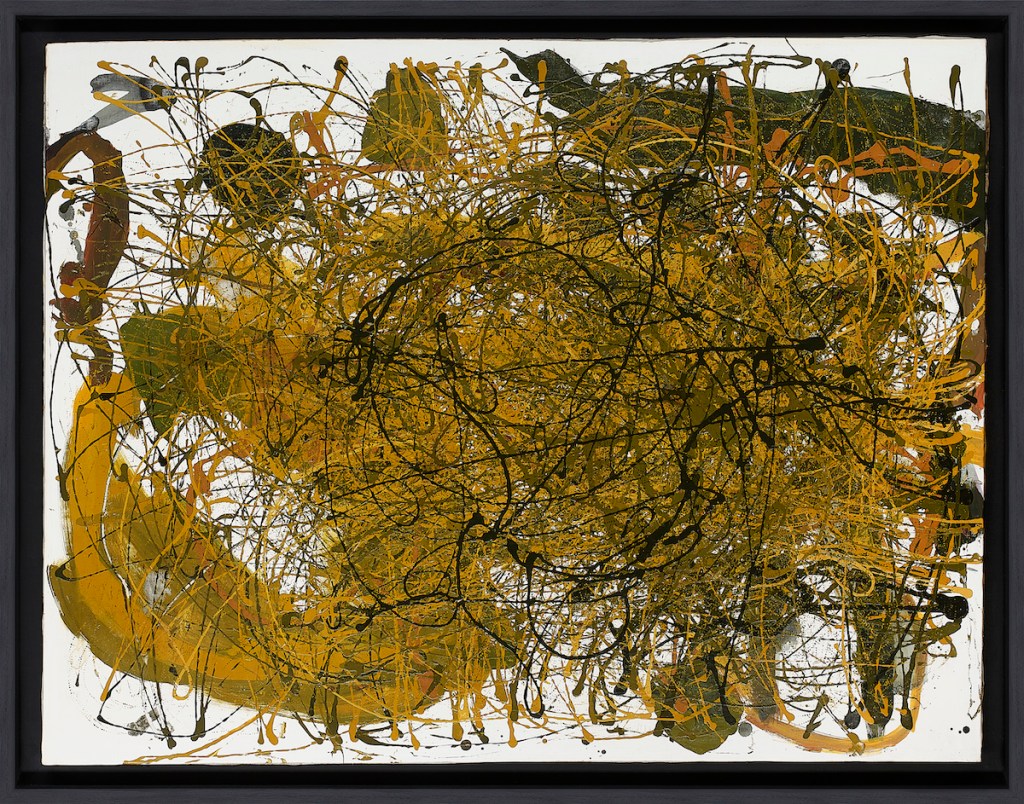Before AI, Two Japanese Artists Took the Human Hand out of Gestural Brushstrokes

This essay originally appeared in Reframed, the Art in America newsletter about art that surprises us and works that get us worked up. Sign up here to receive it every Thursday.
In 1952, the New York–based critic Harold Rosenberg famously described a seismic shift taking place in American painting. No longer, he wrote, were artists coming to a canvas with a predetermined composition that they’d already worked out in a sketch. Now, a painter slathered on strokes and dribbled paint directly.
A few years later, halfway around the world, two Japanese artists, Kazuo Shiraga and Akira Kanayama, took Rosenberg’s idea a step further—eliminating not just the sketch, but also the brush and the human hand.
Shiraga and Kanayama, who are being showcased right now at New York’s Fergus McCaffrey gallery, both found canny ways to produce abstract paintings without lifting a finger during the mid-1950s. Both were associated with the avant-garde Gutai movement of the era. In their paintings, they subverted a notion that was common among the New York–based Abstract Expressionists: that gestural abstraction was deeply human, that it tapped into raw emotions via the artist’s hand.
Kanayama’s paintings eliminate the human touch altogether. To craft his dense drizzles, the artist outfitted a toy car with cans of paint that leaked their contents, dispersing webs of black, red, green, and more across his medium-sized canvases. Kanayama steered his little vehicle around and around, left and right; overlaid swirls were the end result. Using this process, he touched the buttons on the remote control more than he did his own canvases.
Shiraga’s approach verges on parody. Rather than pushing around paint with a brush in hand, he laid his canvases on his studio’s floor—a deliberate allusion to Jackson Pollock’s technique—and pulled around brown and maroon gobs with his feet. Set against white backgrounds, these shit-like messes of color are chunky and thick—so viscous that one can even sometimes spot the ridges formed by Shiraga’s toes. The dance-like choreography needed to make these abstractions replaces the fine motor skills associated with handiwork with more bumbling footwork—but the results don’t betray any lesser command of his materials.
The Fergus McCaffrey show is titled “Plus Minus,” a reference to Shiraga’s assertion that his and Kanayama’s paintings were opposites. Kanayama’s paintings were “cold,” Shiraga said, while his were “hot.” And it is clear, based on this show, that Kanayama’s cold canvases went one step further past the Abstract Expressionist paradigm. Enlisting a little motorized vehicle, these paintings did away with the pretense of sublimity altogether.
If Shiraga’s abstractions ultimately resemble those produced by some New York School artists, Kanayama’s appear totally anathema to the beefy abstractions of Willem de Kooning and Franz Kline. An untitled painting by Kanayama from 1965, included in this show, is composed of a lumpy circular form onto which a flat bed of red squiggles has been overlaid. Despite the blazing brightness of its hues, the painting does not inspire much in the way of transcendence. Instead, its strokes evince a mechanical quality. That is no accident.
Kanayama’s paintings, as well as a few pen drawings that he also made with a remote-controlled car, look forward to questions being asked right now, during a time when AI is raising questions about our species’ role in the process of creating. Early on, Kanayama’s paintings asked these questions as almost everything was being made with the aid of a mechanized counterpart. But rather than stoking existential anxiety, automation seemed to bring the artist a kind of lightness and freedom. For him, it was a way to needle the centrality of human emotion that was so integral to modern art. Tellingly, many of his paintings bear affectless titles. Most of the ones in this show are simply called Work.
© 2024 PMC. All rights reserved.